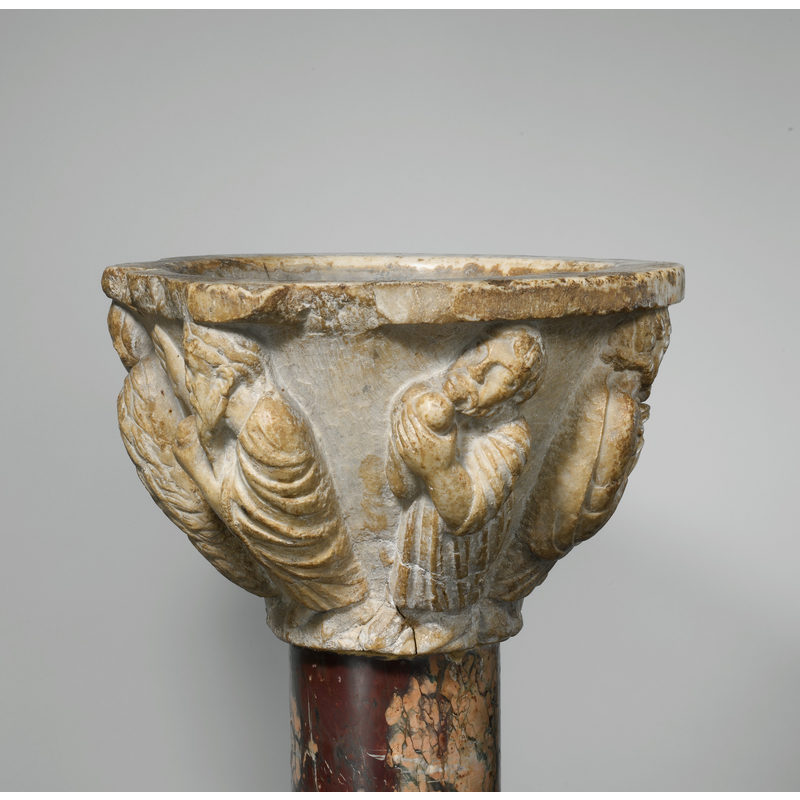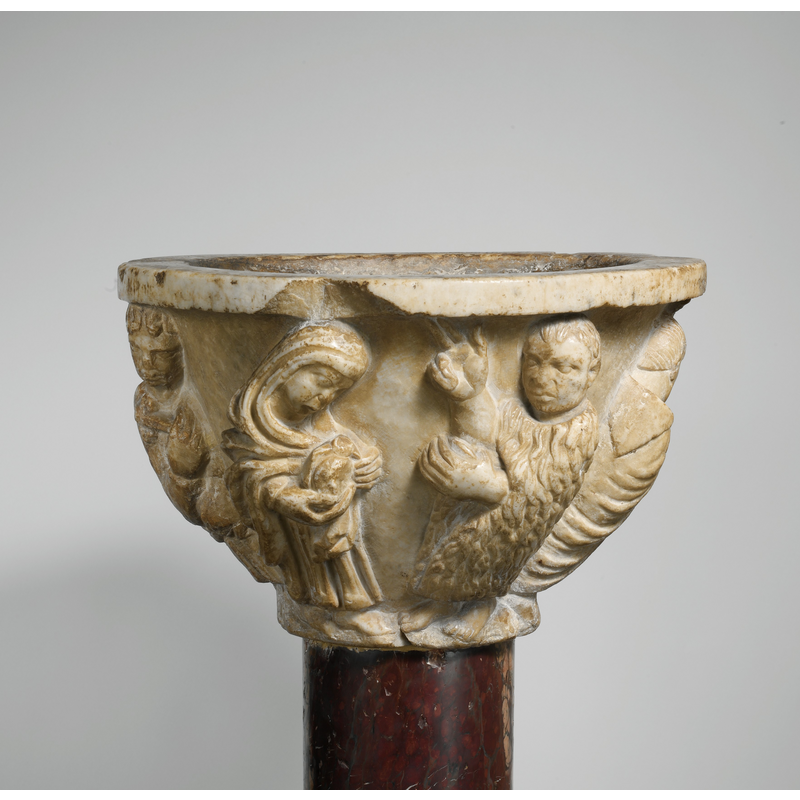New York No. 1

Image copyright © [in the public domain]
OA / Open Access API / PD
Results: 4 records
B01: Apostle or saint - St. Rainerius of Pisa
Scene Description: St Rainerius depicted in a hair-shirt; other scenes from his life depicted around the basin sides
Copyright Statement: Image copyright © [in the public domain]
Image Source: digital photograph in The Cloisters Collection, 1964 [Accession Number: 64.96] [https://images.metmuseum.org/CRDImages/cl/original/DP167915.jpg] [accessed 3 February 2023]
Copyright Instructions: OA / Open Access API / PD
Apostle or saint - St. Rainerius of Pisa
Scene Description: a/p Index of Christian Art # 142543
Copyright Statement: Image copyright © [in the public domain]
Image Source: digital photograph in The Cloisters Collection, 1964 [Accession Number: 64.96] [https://images.metmuseum.org/CRDImages/cl/original/DP167916.jpg] [accessed 3 February 2023]
Copyright Instructions: OA / Open Access API / PD
view of basin
Scene Description: Source caption: "Scenes of the life of Saint Rainerius encircle this font. The son of a merchant of Pisa, he lived for a time in the Holy Land. The saint wears a hair shirt, emblematic of his austere life. Several of Rainerius’ miracles involve holy water; his legend is thus appropriate for a font. Rainerius became the patron saint of Pisa following his death in 1160. Carved in high relief from fine marble, the font probably was created in the workshop of a sculptor named Guglielmus, who was responsible for much of the interior stone decoration of Pisa Cathedral."
Copyright Statement: Image copyright © [in the public domain]
Image Source: digital photograph in The Cloisters Collection, 1964 [Accession Number: 64.96] [https://images.metmuseum.org/CRDImages/cl/original/DP167915.jpg] [accessed 3 February 2023]
Copyright Instructions: OA / Open Access API / PD
view of basin
Scene Description: Source caption: "Scenes of the life of Saint Rainerius encircle this font. The son of a merchant of Pisa, he lived for a time in the Holy Land. The saint wears a hair shirt, emblematic of his austere life. Several of Rainerius’ miracles involve holy water; his legend is thus appropriate for a font. Rainerius became the patron saint of Pisa following his death in 1160. Carved in high relief from fine marble, the font probably was created in the workshop of a sculptor named Guglielmus, who was responsible for much of the interior stone decoration of Pisa Cathedral."
Copyright Statement: Image copyright © [in the public domain]
Image Source: digital photograph in The Cloisters Collection, 1964 [Accession Number: 64.96] [https://images.metmuseum.org/CRDImages/cl/original/DP167916.jpg] [accessed 3 February 2023]
Copyright Instructions: OA / Open Access API / PD
INFORMATION
FontID: 00334NEW
Object Type: Stoup
Museum and Inventory Number: Metropolitan Museum The Cloisters, New York
Church/Chapel: [originally from Tuscany?, probably Pisa?]
Church Location: 99 Margaret Corbin Dr, New York, NY 10040, United States -- Tel.: +1 212-923-3700
Country Name: United States
Location: New York
Directions to Site: The Cloisters [aka Met Cloisters] is located in Fort Tryon Park, in the Washington Heights neighborhood of Upper Manhattan, New York City
Font Location in Church: [in a museum]
Date: ca. 1160?
Century and Period: 12th century, Romanesque
Workshop/Group/Artisan: Workshop of Guglielmo
Font Notes:
Click to view
***GET Open Access / CC-Zero PIC FROM https://www.metmuseum.org/art/collection/search/471922
Reference # 142543 in the Index of Christian Art is captioned "Raynerius of Pisa: scene". The round capital-like font has a rim like an abacus under which are several human figures -carved in very deep relief- in different praying or blessing positions (Raynerius/Rainerius/ Ranieri of Pisa legend; his Christian calendar date is June 17). The MMA's description: "This vase-shaped holy water font displays seven figures on its sloping convex sides. Represented are simple narrative scenes from the life of Saint Rainerius, whos is shown in a long hair shirt. The episodes center on miracles dealing with bread and water. Rainerius lived at Pisa in the twelfth century, and after his death in 1160 he became the patron saint of that city. His life was written by Benincasa, a contemporary and a canon of the cathedral. Rainerius is buried in the cathedral, where this font may have originated and where the scenes depicted would have been easily recognized. The carving of the font has been attributed to the workshop of Guglielmo on the basis of stylistic similarities to his pulpit of 1159-62, formerly in the cathedral of Pisa and now in the cathedral of Cagliari, Sardinia." (Wixom, 1989) -- The Cloisters [https://www.metmuseum.org/art/collection/search/471922] [accessed 2 February 2023]
COORDINATES
Church Latitude & Longitude Decimal: 40.8648, -73.9319
Church Latitude & Longitude DMS: 40° 51′ 53.28″ N, 73° 55′ 54.84″ W
UTM: 18T 590013 4524298
MEDIUM AND MEASUREMENTS
Material: stone, marble (Carrara)
Number of Pieces: one
Font Shape: cauldron-shaped
Basin Interior Shape: round
Basin Exterior Shape: round
Diameter (includes rim): 38.10 cm
Font Height (less Plinth): ca. 30 cm
Notes on Measurements: Wixom (1989)
REFERENCES
Index of Medieval Art, The Index of Medieval Art, Index of Christian Art, Princeton, [s.d.]. URL: https://theindex.princeton.edu/.
Wixom, William D., Medieval Sculpture at the Cloisters, New York: Metropolitan Museum of Art, 1989
